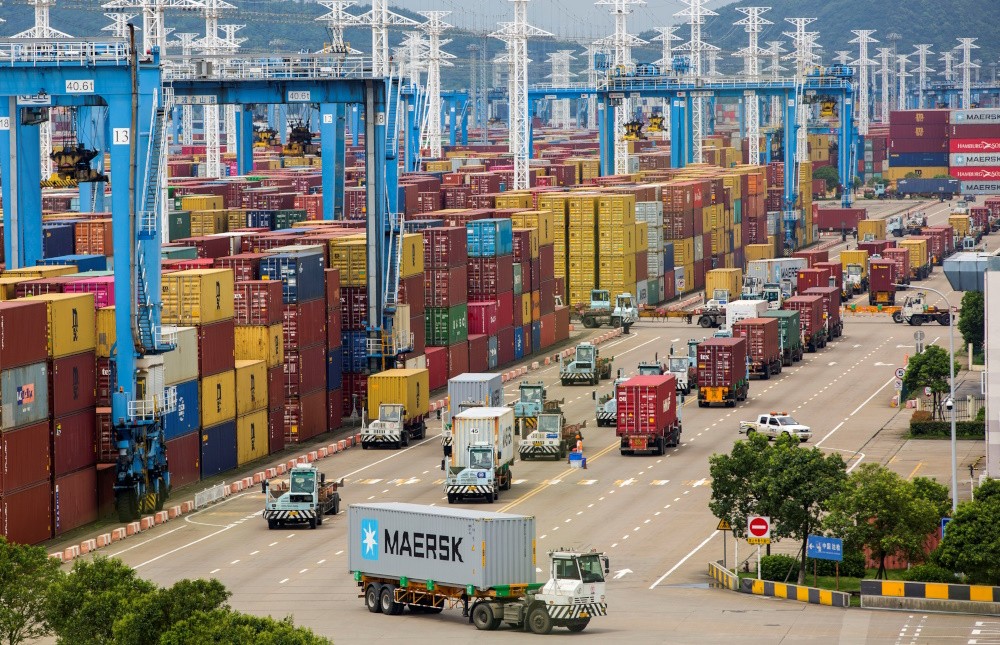China’s global exports are surging at an unprecedented rate

China’s global exports are poised for significant growth, signaling the onset of a new wave in international trade. Recent figures released by China’s central bank indicate that state-controlled banks have extended an additional $1.9 trillion in loans to industrial borrowers over the last four years. Across the outskirts of cities throughout China, a surge in factory construction is taking place around the clock, while established facilities are undergoing significant enhancements through the integration of robotics and automation technologies.
China’s strategic investments and advancements in manufacturing are generating a significant surge in exports, raising concerns about potential factory closures and layoffs not only in the United States but also worldwide. “The impending tsunami poses a threat to all,” stated Katherine Tai, who served as the United States trade representative under former President Joe Biden. President Donald Trump’s announcement of steep tariffs on Wednesday marks the most significant response to China’s export strategy, triggering a sharp decline in stock markets across Asia and beyond. Countries such as Brazil, Indonesia, Thailand, and members of the European Union have taken steps to raise tariffs, albeit with a more subdued approach.
Chinese leaders have expressed strong discontent regarding the recent surge in trade barriers, with particular emphasis on the latest tariffs imposed by Trump. China’s economic landscape is characterized by a notable high savings rate, extensive work hours, and a wealth of engineers and software programmers. Additionally, the country boasts a significant workforce of electricians, welders, mechanics, construction workers, and other skilled tradespeople, all contributing to its robust industrial capabilities.
During a broadcast on state television Saturday night, an anchor delivered a government statement that criticized the United States. The statement asserted, “It is using tariffs to subvert the existing international economic and trade order” in order “to serve the hegemonic interests of the United States.”
Five years prior, prior to the collapse of a housing bubble, construction cranes erecting apartment towers were a common sight in nearly every city across China. Currently, a significant number of cranes have been removed from the landscape, and those that remain are infrequently operational. In a strategic move prompted by Beijing, financial institutions have swiftly redirected their lending focus from the real estate sector to industrial investments.
Five years prior, prior to the collapse of a housing bubble, construction cranes erecting apartment towers were a common sight across nearly every city in China. Currently, a significant number of cranes have been removed, and those that remain are infrequently operational. In a strategic move prompted by Beijing, financial institutions have swiftly redirected their lending practices from the real estate sector towards industrial investments.
For many years, Volkswagen’s sprawling complex in Wolfsburg, Germany, held the title of the world’s largest car factory. BYD, the prominent Chinese electric vehicle manufacturer, is in the process of constructing two factories in China, each with the capacity to produce double the number of vehicles compared to Wolfsburg. With the launch of new factories, China’s export growth is gaining significant momentum. The figures increased by 13.3% in 2023, followed by an additional rise of 17.3% in the subsequent year.
China has emerged as the global leader in factory robot utilization, surpassing the combined usage of the rest of the world. Notably, the majority of these robots are domestically produced by Chinese manufacturers, despite the continued importation of certain components. Following a period of significant expansion, the total installations of new factory equipment have surged by an additional 18% this year. Four years ago, Zeekr, a Chinese electric vehicle manufacturer, inaugurated a factory in Ningbo, located two hours south of Shanghai, equipped with 500 robots. The current count stands at 820, with numerous additional plans in the pipeline.
Lending from state banks is driving a significant surge in corporate research and development activities. Huawei, a diversified conglomerate known for its production of smartphones and auto parts, has inaugurated a new research center in Shanghai. This facility is designed to accommodate 35,000 engineers and boasts office and laboratory space that is tenfold that of Google’s headquarters located in Mountain View, California. Global leaders are currently grappling with the decision of whether to implement trade barriers in an effort to safeguard the remaining segments of their nations’ industrial sectors.
China has consistently increased its presence in the global manufacturing sector over the past several decades. The expansion was primarily realized at the cost of the United States and other established industrial nations, as well as emerging economies. China’s market share has surged to 32%, a significant increase from just 6% in the year 2000. China’s factory output surpasses the total manufacturing output of the United States, Germany, Japan, South Korea, and Britain combined.
Prior to Trump’s potential second term, officials from the Biden administration raised concerns during their last year in office regarding the issue of industrial overcapacity in China. The government has implemented an increase in tariffs, particularly affecting the electric vehicle sector. In the initial three years of the Biden administration, officials primarily concentrated on implementing stricter export controls for advanced technologies, including high-end semiconductors, emphasizing national security considerations. The administration has maintained tariffs ranging from 7.5% to 25% that were originally implemented by the Trump administration on approximately half of China’s exports to the United States during his first term.
The outcome of the president’s significantly more aggressive strategy remains unclear at this juncture. While tariffs have at times hindered the growth of China’s exports, they have not been able to halt it entirely. Countries around the globe are closely monitoring the situation, as there are concerns that Chinese exports may be redirected, posing risks to the economies of traditional U.S. allies, including the European Union and South Korea.
In 2017, as Donald Trump assumed the presidency, China’s automakers were gearing up for an entry into the American car market. In November, GAC Motor, based in Guangzhou, China, hosted a significant presence at the city’s auto show by inviting dozens of U.S. car dealers to participate. The company has revealed its strategy to introduce gasoline-powered SUVs and minivans to the U.S. market by the conclusion of 2019. However, GAC and other Chinese automakers have scrapped their plans following the inclusion of cars in Trump’s initial 25% tariffs announced several months later. Chinese manufacturers continue to have a minimal presence in the U.S. automotive market, with sales of their vehicles remaining nearly nonexistent. It appears that this situation is not expected to evolve. In a significant development, Chinese car manufacturers are now confronted with U.S. tariffs reaching as high as 181% following recent actions taken by Trump.
Despite facing restrictions in the United States, Chinese automakers are actively expanding their manufacturing capabilities and redirecting their export strategies to alternative markets. Sales have experienced significant growth in Australia and Southeast Asia, capturing market share from both Japanese and American brands. In Mexico, the market share of Chinese carmakers was a mere 0.3% in 2017; however, by the end of last year, this figure surged to over 20%. In October, EU officials responded to significant sales increases within the European market and indications of subsidies from the Chinese government by implementing tariffs as high as 45% on electric vehicles imported from China.
China is expanding its automotive manufacturing capabilities beyond mere factory construction. In the last five years, the region has significantly expanded its petrochemical refinery capacity, surpassing the combined output of Europe, Japan, and South Korea since World War II. China is poised to accelerate the construction of these refineries this year. Petrochemicals are subsequently transformed into a variety of products, including plastics, polyester, vinyl, and tires.
Robert E. Lighthizer, former U.S. trade representative during the Trump administration, stated that the recent U.S. tariffs are “long overdue medicine,” attributing the underlying issue to decades of Chinese industrial policy that has led to significant overcapacity and global economic imbalances.
China’s robust export activity can be attributed in part to the subdued consumption levels among its domestic population. The housing market has experienced a significant downturn since 2021, leading to substantial losses in savings for the middle class and adversely affecting numerous affluent families. Tax revenues are experiencing a decline, while military expenditures are increasing at a significant pace. The government remains cautious regarding expenditures on economic stimulus aimed at assisting consumers. China has mitigated its housing crisis through an aggressive export initiative, resulting in the creation of millions of jobs dedicated to the construction, outfitting, and operation of factories.
Recent discussions among Chinese economists have aligned with those of their Western counterparts, advocating for the enhancement of the country’s limited social safety net. At the beginning of this year, the minimum government pension allocated for seniors stood at a mere $17 per month. The amount is insufficient to cover grocery expenses, even in rural areas of China. In a significant statement made in January, renowned economist and Tsinghua University professor Li Daokui advocated for a substantial increase in the minimum monthly pension, proposing it be raised to $110. An analysis suggests that the Chinese government has the financial capacity to support increased spending, particularly by seniors, which could serve as a catalyst for broader economic stimulation.
Chinese officials have dismissed his recommendations. The budget released on March 5 included an increase in monthly pensions; however, the adjustment was minimal, amounting to just $3, raising the total to $20 per month. The budget allocates $100 billion for investments, focusing on ports and other infrastructure that support exporters. A new initiative has been launched to enhance the technology utilized in manufacturing across 20 cities in China.










